Accidentally spilled some water on your MacBook and it turns off suddenly? Unsure of what steps you should take to minimize the damage to your IT product? Find out on how to prevent the unthinkable and minimize the risk of any further damage by reading this repair guide. Compiled by many experts in this field whom had troubleshoot many Macbook Water Damage Repair, this guide aims to deliver non-tech savvy individuals with advice and ways to increase the success rate of their Macbook surviving during a liquid spillage. It includes an in-depth analysis of the Macbook design and best approach to take for different model.
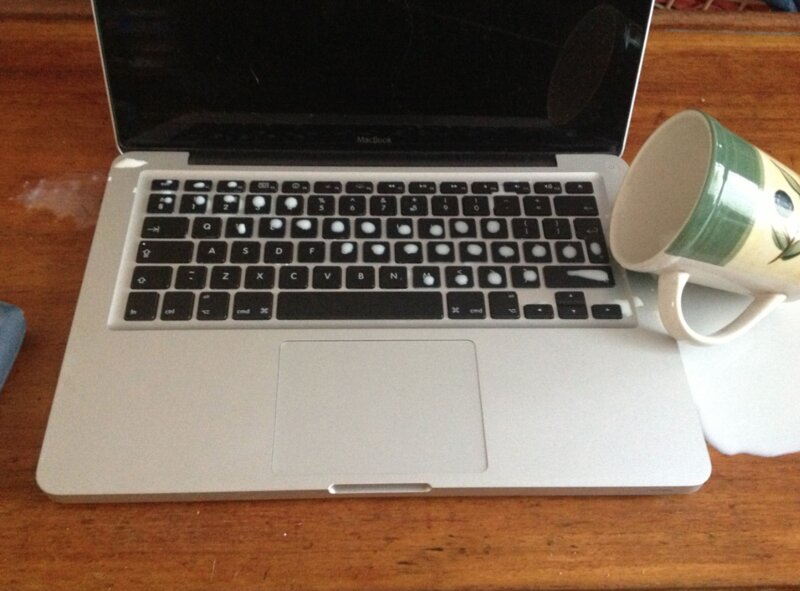
Without wasting any time, firmly press down onto your device's power button for a minimum of five seconds or more until your MacBook shuts down. Concerned this will impact your precious data, images, and documents? Trust us; this step is the only way to salvage data present on your device. Try to avoid getting your hands near that button again, as it is possible to accidentally turn on your MacBook, a step that is irrelevant and might cause more harm to your device in this stage.
In case you're in a circumstance where you are unable to turn off your device by pressing down on the power button, the water damage has likely caused your MacBook keyboard to malfunction or not function at all. However, there are still other ways you can use to force shutdown your device.
Using a washcloth, tissues, or any other absorbent material, clean and eliminate any water or liquid visible on the keyboard and screen's surface. After this procedure, close the lid of your MacBook to activate the sleep sensors in your MacBook. This action, in turn, will shut down the power supply to the CPU and other various components of your MacBook after the logic board identifies the sleep sensor signal.
Doing so will cause your MacBook to be in a shallow sleep mode phase. In such a condition, your MacBook is still running as the chips are still receiving power. However, keeping the lid closed will cause your device to enter into the deep sleep mode. During this, the power supply to memory chips is cut off, rendering your MacBook device to shut down. This method is also a safe and efficient way of protecting your RAM, CPU, and SSD drive. It is advised not to open the laptop's lid during these steps to ensure that your MacBook does not randomly switch on again.
However, a MacBook may still be operating if its screen light is on, despite users carrying out the steps given above. In such instances, technicians conclude that the water damage causes your logic board to malfunction and is uncontrollable. Unplugging your charger as a way of disconnecting the battery may still be a way of salvaging your logic board if the water spillage has not impaired it.

Users find it relatively easy to follow this step as compared to the first one. However, users should keep in mind that merely unplugging your charger will not completely shut down your MacBook, as power supplication will continue to your MacBook’s CPU and other various parts of the device. Due to this, the first step is essential, and users need to shut down their MacBook by any means.
Unplugging the charger will switch off the charging circuit that is present in the logic board. This is quite a necessary step as the charging circuit's high voltage can be quite damaging to your MacBook and may even pose a threat. On another note, the damage to charging circuits is repairable by a technician and isn't something users should fret over.
In this step, succeeding means that 99% of the logic board circuits present in your MacBook are turned off. The only circuit turned on at this point is the standby circuit, which usually does not prove to be a threat in such cases.
The charger outputs present in the MacBook Pro and MacBook Air are 16.5-20 volts and 14.5 volts, respectively. There is a widespread belief amongst users that accidentally coming in contact with your laptop will result in users getting a shock, which is not the case. The MagSafe charging ports shut down instantly as soon as the sensors detect a leakage current. Even in situations where your charger is submerged in water, it is still not dangerous to come into contact with your water-damaged MacBook. However, the charger can be quite dangerous, should be unplugged from the main socket immediately.

Technicians advise users to keep their MacBook in the exact position it was before and after water spillage. After they follow the above-given steps, users should prevent water from seeping into the vent holes of the MacBook by blocking it with cloth or other materials. These holes placed strategically between the keyboard and the screen help ventilate your device and transfer heat from the logic board into the atmosphere. Blocking the vent holes will prevent water from damaging the logic board placed inside of the MacBook.
As you can see in the picture below, there is absolutely nothing present between the logic board and the vent holes. Blocking the vent holes will only help lower the damage caused to your MacBook as a whole. Users can also wipe off any other excess or remaining water on the components of the MacBook.
We have surveyed far and wide and have gathered enough data to inform us that 80% of the time, water seepage had damaged the MacBook's logic board. This makes blocking the vent holes a crucial step in your MacBook's recovery process. Water seepage can also affect your MacBook by entering through gaps present in the USB port, charging port, HDMI, and the tiny spaces between the touchpad. Due to the size of the cavities being small, the amount of water entered is relatively less; however, it can still be harmful for your device.
The keyboard of the MacBook Pro and Air has been designed in such a manner that it is airtight. The backlighting part of the keyboard gives additional protection to the keyboard. It further seals the device and components underneath it, rendering it impossible for water to seep in and affect or damage the logic board. Although adding a silicone cover to your keyboard may help protect it from water damage, it can also be detrimental to the logic board. Silicone covers may encourage water to spread and then leak into the holes and affect the logic board.
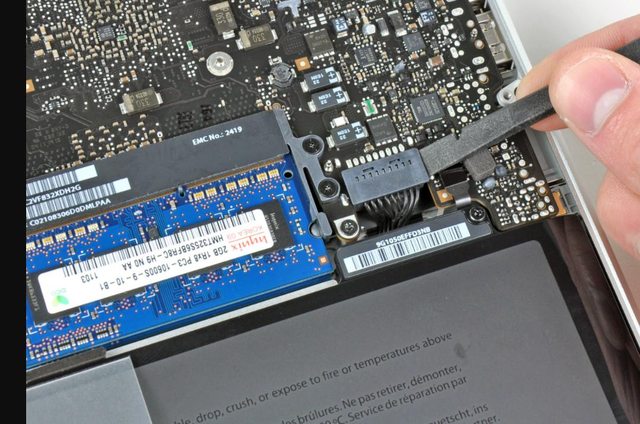
For this step, you'll probably need a Phillip or pentagon screwdriver, depending upon the model of your MacBook. Flip over your device, unscrew the back case, and use a non-metal stick to take out the battery connector from the logic board safely.
It is very unsafe and not advised to use a metal screwdriver. This could cause further damage to your battery, such as by destruction of the System Management controller or by short-circuiting a battery. Wreckage of your System Management Controller will leave your MacBook useless, as it is currently impossible to get it replaced by purchasing a new one directly from possible. The only way you can get the SMC replaced is by retaining it from a dead MacBook of the exact same model and year.
If you've reached this step, there are no other ways of your MacBook getting damaged or your data getting lost. The only action to take now is by taking your damaged device to a Macbook Repair in Singapore who will get it up and running again.
Hitec Repair has salvaged multiple water damaged MacBooks every year and has left customers happy and satisfied with their services. If you're unfortunately facing the case of a liquid-damaged MacBook, you can reach out to us for a free diagnostic.
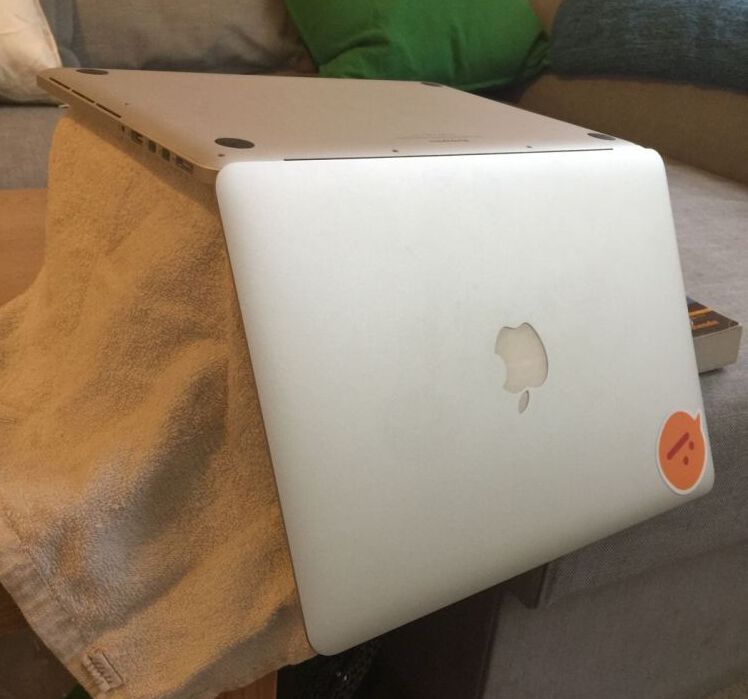
A total of two methods can be adopted for draining water from your MacBook, and to get it functioning again.
Method 1: If you own a pre-2013 MacBook pro or pre-2018 MacBook Air coupled with a non-retina screen, the best way to drain it is by firstly placing it in an upside-down V shape or "tent" position. Non-retina screen MacBooks usually come with a protective glass casing or aluminum frame that stops water from seeping into the screen.
The upside-down V position is not advised for non-retina screen Macbooks, as their screens are slimmer and less firm due to the removal of the protective glass casing and the sturdy aluminum frame. They are also not water-resistant and can further encourage the spread of water inside your screen, which will impact the quality of images, as seen in the picture below. This will incur additional repair costs of around $500-$1200 for replacing the retina screen, which might be out of most users' budgets.
Raise your device's lid and make sure it is exactly or close to a 90-degree angle. With the screen facing downwards and the keyboard part hanging, place your MacBook right at the edge of a tabletop or a benchtop. The flat-screen position will prevent water from dripping or leaking inside it and promote a quicker drying process of the water that has already seeped inside your device. Additional protection practices are also recommended, such as placing a frictional substance (paper or towel) beneath the screen part to avoid it from falling off of the edge and getting damaged even more.
Method 2: Apple has a general design for Macbooks, placing the battery under the touchpad and the logic board underneath the keyboard. Gravity will force the water present in the keyboard section towards the touchpad, thus removing it from the MacBook case as a whole. The entire drying process for water damaged Macbooks should not be more than 24 hours after removing the bottom cover.
Warning: Professionals advise against removing the lid from MacBook Air 2018 and Pro 2016 models, and onwards. Opening the lid will switch on the device, an action not necessary for this step. In case users face such a situation, they should follow the steps given above to power off their MacBook and get it looked at by professionals immediately.
Whatever the situation is, do not, in any case, shake your water damaged device as this will only make the water stretch out and reach more intricate and complicated parts of the MacBook, such as the screen's backlight film.
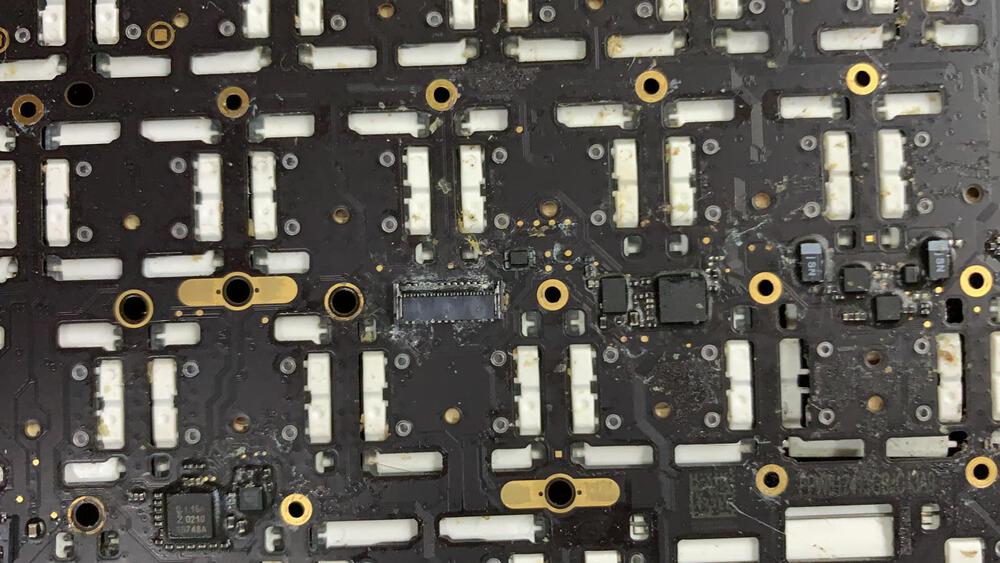
It is possible that the spillage of water on your MacBook did not impact any internal devices such as the logic board and only affected external components such as the keyboard. However, one can confirm suspicions of the logic board getting damaged or affected by viewing it from under a microscope. A proper inspection will let you know whether it is possible to turn on your MacBook despite the damage or not. Professional technicians and experts will always view the logic board first before trying to turn on the device.
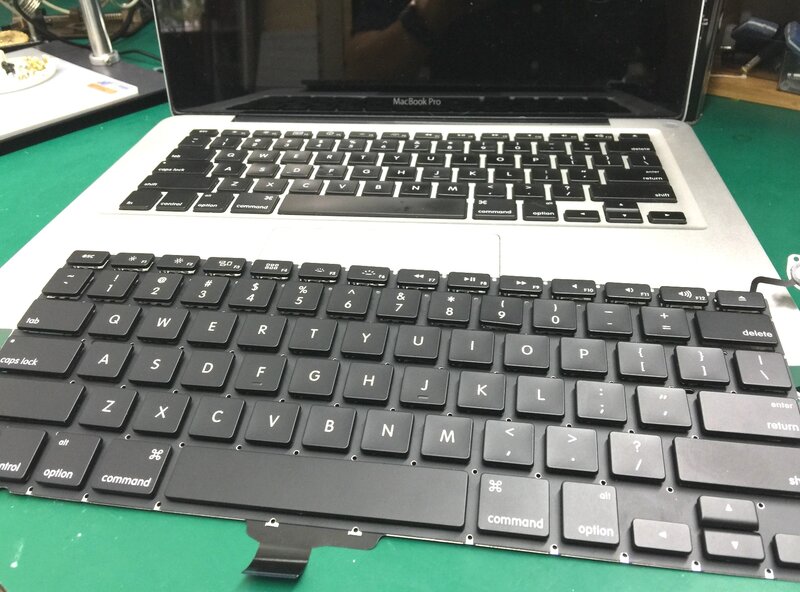
It would be best if you only took your water damaged MacBook to highly trained professionals that have a reputation for their exceptional services. These technicians follow various levels of services, which are mentioned as below.
Level 1: The logic board, along with other components of the MacBook, is cleaned. Various elements, such as the Keyboard or Trackpad replacement, LCD screen replacement, and Battery replacement, and Harddisk replacement if required. After assembling the components, the MacBook is turned on to test out the logic board, which, if it happens to work improperly or not work at all, will deem the MacBook as not repairable. The only solution will be to completely replace the logic board, which can be expensive if you acquire a brand-new logic board. An assessment fee for such services is charged, and users can obtain this level of service from most Apple authorized repairers, as well as third-party ones.
Unfortunately, data recovery is not a part of Apple's services, and you can only get your data recovered through third party alliances. However, the service expenses will be covered by Apple for you if you have already bought AppleCare+ for Mac.
Level 2: The components of the MacBook are cleaned and replaced if required. Corroded chips that are lodged onto the logic board are either repaired or replaced by experienced and proficient technicians. This process generally ends up being successful, and an assessment fee may not be a part of the total amount charged for services. Only a few possess the knowledge and skills to execute this task flawlessly when it comes to third-party repairers.
Level 3: The services provided in Level 2 will be executed, along with faulty chips going through a separate troubleshooting process. Most third-party repairers may not possess the equipment required for this process, along with the knowledge and understanding concerning MacBook’s' unique logic board design. An assessment fee is not included in the costs due to a high chance of the process being successful.
Accidentally spilled some water on your MacBook and it turns off suddenly? Unsure of what steps you should take to minimize the damage to your IT product? Find out on how to prevent the unthinkable and minimize the risk of any further damage by reading this repair guide. Compiled by many experts in this field whom had troubleshoot many Macbook Water Damage Repair, this guide aims to deliver non-tech savvy individuals with advice and ways to increase the success rate of their Macbook surviving during a liquid spillage. It includes an in-depth analysis of the Macbook design and best approach to take for different model.

Without wasting any time, firmly press down onto your device's power button for a minimum of five seconds or more until your MacBook shuts down. Concerned this will impact your precious data, images, and documents? Trust us; this step is the only way to salvage data present on your device. Try to avoid getting your hands near that button again, as it is possible to accidentally turn on your MacBook, a step that is irrelevant and might cause more harm to your device in this stage.
In case you're in a circumstance where you are unable to turn off your device by pressing down on the power button, the water damage has likely caused your MacBook keyboard to malfunction or not function at all. However, there are still other ways you can use to force shutdown your device.
Using a washcloth, tissues, or any other absorbent material, clean and eliminate any water or liquid visible on the keyboard and screen's surface. After this procedure, close the lid of your MacBook to activate the sleep sensors in your MacBook. This action, in turn, will shut down the power supply to the CPU and other various components of your MacBook after the logic board identifies the sleep sensor signal.
Doing so will cause your MacBook to be in a shallow sleep mode phase. In such a condition, your MacBook is still running as the chips are still receiving power. However, keeping the lid closed will cause your device to enter into the deep sleep mode. During this, the power supply to memory chips is cut off, rendering your MacBook device to shut down. This method is also a safe and efficient way of protecting your RAM, CPU, and SSD drive. It is advised not to open the laptop's lid during these steps to ensure that your MacBook does not randomly switch on again.
However, a MacBook may still be operating if its screen light is on, despite users carrying out the steps given above. In such instances, technicians conclude that the water damage causes your logic board to malfunction and is uncontrollable. Unplugging your charger as a way of disconnecting the battery may still be a way of salvaging your logic board if the water spillage has not impaired it.

Users find it relatively easy to follow this step as compared to the first one. However, users should keep in mind that merely unplugging your charger will not completely shut down your MacBook, as power supplication will continue to your MacBook’s CPU and other various parts of the device. Due to this, the first step is essential, and users need to shut down their MacBook by any means.
Unplugging the charger will switch off the charging circuit that is present in the logic board. This is quite a necessary step as the charging circuit's high voltage can be quite damaging to your MacBook and may even pose a threat. On another note, the damage to charging circuits is repairable by a technician and isn't something users should fret over.
In this step, succeeding means that 99% of the logic board circuits present in your MacBook are turned off. The only circuit turned on at this point is the standby circuit, which usually does not prove to be a threat in such cases.
The charger outputs present in the MacBook Pro and MacBook Air are 16.5-20 volts and 14.5 volts, respectively. There is a widespread belief amongst users that accidentally coming in contact with your laptop will result in users getting a shock, which is not the case. The MagSafe charging ports shut down instantly as soon as the sensors detect a leakage current. Even in situations where your charger is submerged in water, it is still not dangerous to come into contact with your water-damaged MacBook. However, the charger can be quite dangerous, should be unplugged from the main socket immediately.

Technicians advise users to keep their MacBook in the exact position it was before and after water spillage. After they follow the above-given steps, users should prevent water from seeping into the vent holes of the MacBook by blocking it with cloth or other materials. These holes placed strategically between the keyboard and the screen help ventilate your device and transfer heat from the logic board into the atmosphere. Blocking the vent holes will prevent water from damaging the logic board placed inside of the MacBook.
As you can see in the picture below, there is absolutely nothing present between the logic board and the vent holes. Blocking the vent holes will only help lower the damage caused to your MacBook as a whole. Users can also wipe off any other excess or remaining water on the components of the MacBook.
We have surveyed far and wide and have gathered enough data to inform us that 80% of the time, water seepage had damaged the MacBook's logic board. This makes blocking the vent holes a crucial step in your MacBook's recovery process. Water seepage can also affect your MacBook by entering through gaps present in the USB port, charging port, HDMI, and the tiny spaces between the touchpad. Due to the size of the cavities being small, the amount of water entered is relatively less; however, it can still be harmful for your device.
The keyboard of the MacBook Pro and Air has been designed in such a manner that it is airtight. The backlighting part of the keyboard gives additional protection to the keyboard. It further seals the device and components underneath it, rendering it impossible for water to seep in and affect or damage the logic board. Although adding a silicone cover to your keyboard may help protect it from water damage, it can also be detrimental to the logic board. Silicone covers may encourage water to spread and then leak into the holes and affect the logic board.

For this step, you'll probably need a Phillip or pentagon screwdriver, depending upon the model of your MacBook. Flip over your device, unscrew the back case, and use a non-metal stick to take out the battery connector from the logic board safely.
It is very unsafe and not advised to use a metal screwdriver. This could cause further damage to your battery, such as by destruction of the System Management controller or by short-circuiting a battery. Wreckage of your System Management Controller will leave your MacBook useless, as it is currently impossible to get it replaced by purchasing a new one directly from possible. The only way you can get the SMC replaced is by retaining it from a dead MacBook of the exact same model and year.
If you've reached this step, there are no other ways of your MacBook getting damaged or your data getting lost. The only action to take now is by taking your damaged device to a Macbook Repair in Singapore who will get it up and running again.
Hitec Repair has salvaged multiple water damaged MacBooks every year and has left customers happy and satisfied with their services. If you're unfortunately facing the case of a liquid-damaged MacBook, you can reach out to us for a free diagnostic.

A total of two methods can be adopted for draining water from your MacBook, and to get it functioning again.
Method 1: If you own a pre-2013 MacBook pro or pre-2018 MacBook Air coupled with a non-retina screen, the best way to drain it is by firstly placing it in an upside-down V shape or "tent" position. Non-retina screen MacBooks usually come with a protective glass casing or aluminum frame that stops water from seeping into the screen.
The upside-down V position is not advised for non-retina screen Macbooks, as their screens are slimmer and less firm due to the removal of the protective glass casing and the sturdy aluminum frame. They are also not water-resistant and can further encourage the spread of water inside your screen, which will impact the quality of images, as seen in the picture below. This will incur additional repair costs of around $500-$1200 for replacing the retina screen, which might be out of most users' budgets.
Raise your device's lid and make sure it is exactly or close to a 90-degree angle. With the screen facing downwards and the keyboard part hanging, place your MacBook right at the edge of a tabletop or a benchtop. The flat-screen position will prevent water from dripping or leaking inside it and promote a quicker drying process of the water that has already seeped inside your device. Additional protection practices are also recommended, such as placing a frictional substance (paper or towel) beneath the screen part to avoid it from falling off of the edge and getting damaged even more.
Method 2: Apple has a general design for Macbooks, placing the battery under the touchpad and the logic board underneath the keyboard. Gravity will force the water present in the keyboard section towards the touchpad, thus removing it from the MacBook case as a whole. The entire drying process for water damaged Macbooks should not be more than 24 hours after removing the bottom cover.
Warning: Professionals advise against removing the lid from MacBook Air 2018 and Pro 2016 models, and onwards. Opening the lid will switch on the device, an action not necessary for this step. In case users face such a situation, they should follow the steps given above to power off their MacBook and get it looked at by professionals immediately.
Whatever the situation is, do not, in any case, shake your water damaged device as this will only make the water stretch out and reach more intricate and complicated parts of the MacBook, such as the screen's backlight film.

It is possible that the spillage of water on your MacBook did not impact any internal devices such as the logic board and only affected external components such as the keyboard. However, one can confirm suspicions of the logic board getting damaged or affected by viewing it from under a microscope. A proper inspection will let you know whether it is possible to turn on your MacBook despite the damage or not. Professional technicians and experts will always view the logic board first before trying to turn on the device.

It would be best if you only took your water damaged MacBook to highly trained professionals that have a reputation for their exceptional services. These technicians follow various levels of services, which are mentioned as below.
Level 1: The logic board, along with other components of the MacBook, is cleaned. Various elements, such as the Keyboard or Trackpad replacement, LCD screen replacement, and Battery replacement, and Harddisk replacement if required. After assembling the components, the MacBook is turned on to test out the logic board, which, if it happens to work improperly or not work at all, will deem the MacBook as not repairable. The only solution will be to completely replace the logic board, which can be expensive if you acquire a brand-new logic board. An assessment fee for such services is charged, and users can obtain this level of service from most Apple authorized repairers, as well as third-party ones.
Unfortunately, data recovery is not a part of Apple's services, and you can only get your data recovered through third party alliances. However, the service expenses will be covered by Apple for you if you have already bought AppleCare+ for Mac.
Level 2: The components of the MacBook are cleaned and replaced if required. Corroded chips that are lodged onto the logic board are either repaired or replaced by experienced and proficient technicians. This process generally ends up being successful, and an assessment fee may not be a part of the total amount charged for services. Only a few possess the knowledge and skills to execute this task flawlessly when it comes to third-party repairers.
Level 3: The services provided in Level 2 will be executed, along with faulty chips going through a separate troubleshooting process. Most third-party repairers may not possess the equipment required for this process, along with the knowledge and understanding concerning MacBook’s' unique logic board design. An assessment fee is not included in the costs due to a high chance of the process being successful.
| Product Image | Product Model | View |
|---|---|---|
 | Macbook Pro 17-inch A1297 | |
 | MacBook Pro 16-inch Late 2023 A2991 | |
 | Macbook Pro 16-inch 2021 A2485 | |
 | Macbook Pro 16-inch 2019 A2141 | |
 | Macbook Pro 15-inch Retina A1398 | |
 | Macbook Pro 15-inch A1286 | |
 | Macbook Pro 15-inch 2018-19 A1990 | |
 | Macbook Pro 15-inch 2016-17 A1707 | |
 | MacBook Pro 14-inch 2023 A2918 | |
 | Macbook Pro 14-inch 2023 A2779 | |
 | Macbook Pro 14-inch 2021 A2442 | |
 | Macbook Pro 13-inch Touchbar A1706 2017 | |
 | Macbook Pro 13-inch Retina A1502 | |
 | Macbook Pro 13-inch Non-Touchbar A1708 | |
 | Macbook Pro 13-inch M1 A2338 | |
 | Macbook Pro 13-inch A1278 | |
 | Macbook Pro 13-inch 2020 A2251,A2289 | |
 | Macbook Pro 13-inch 2018-19 A1989 | |
 | MacBook Air 15-inch 2024 A3114 | |
 | MacBook Air 15-inch 2023 A2941 | |
 | MacBook Air 13-inch M2 A2681 | |
 | MacBook Air 13-inch M1 A2337 | |
 | MacBook Air 13-inch A2179 | |
 | MacBook Air 13-inch A1932 | |
 | MacBook Air 13-inch 2011-17 A1369,A1466 | |
 | MacBook Air 11-inch A1370,A1465,A1933 | |
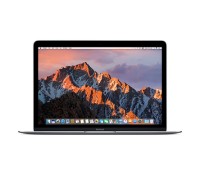 | MacBook 12-inch A1534 | |